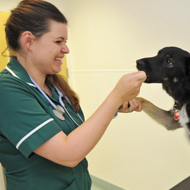Rescuers save stuck fox from slurry lagoon
The fox spent the night at a nearby veterinary practice.
A fox has been successfully rescued by the RSPCA and fire service after becoming trapped on the plastic sheeting covering a slurry lagoon.
The animal had wandered onto the covering of the slurry lagoon on a farm in Warminster, Wiltshire, but was unable to get off it as rainwater had pooled on the sheeting and the steep sides had become slippery.
The farmer, unable to coax the fox to safety, called the RSPCA. However, the animal rescue officer who attended, Gemma Gumbleton, was also unable to rescue the trapped animal by herself.
Ms Gumbleton said: “My usual rescue poles just wouldn’t stretch far enough, and because of his anxiety, the panicked wild animal wouldn’t stay still to allow me to reach him anyway.
“Because of these challenges, I knew this rescue would need specialists with expert skills, so I contacted the local Dorset and Wiltshire Fire and Rescue Service.”
Three units arrived from the fire and rescue service. Using an inflatable raft, they were able to get onto the sheeting, but the fox continued to evade their best efforts to catch it.
Eventually, more than three hours into the rescue mission, the fox was so tired, cold, and wet that it stopped moving about. A member of the fire and rescue team was able to climb onto the sheeting and put the animal into a rescue container.
The fox was taken to a local veterinary practice where he was checked over and stayed overnight.
Ms Gumbleton continued: “I was so worried the fox wouldn’t survive; the shock of this kind of experience can often kill a wild animal. But the next morning, I was relieved and delighted to discover him looking bright-eyed and bushy tailed so it was time for me to return him to the wild.
"I transported him near to - but not too near - the place where he got himself into such a pickle, then let him out of the container and he immediately ran off into the countryside.”
Image © Shutterstock



 Zoetis is to present a CPD event for free to members of the British Veterinary Nursing Association (BVNA).
Zoetis is to present a CPD event for free to members of the British Veterinary Nursing Association (BVNA).